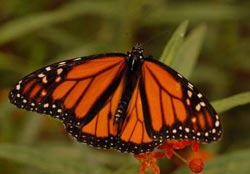Monarch butterflies migration path tracked by generations for first time

A new study from the University of Guelph tracks monarch butterflies migration pattern, and follows them by generation. This study provides some clues as to why the butterflies population has been dropping recently.<br><br>Credit: University of Guelph - Jessica Linton<br>
Until now, linking adult butterflies and their birthplaces during a complicated annual migration spanning all of eastern North America and involving up to five generations of the iconic insects had eluded scientists.
Now for the first time, researchers have mapped that migration pattern across the continent over an entire breeding season. That information might help conserve a creature increasingly threatened by loss of habitat and food sources, says Tyler Flockhart, a PhD student in U of G's Department of Integrative Biology.
“This tells us where individuals go and where they're coming from,” he said.
Flockhart is lead author of a paper published [online Aug. 7: embargo] in the Proceedings of the Royal Society B with Prof. Ryan Norris and co-authors based in Saskatchewan, Colorado and Australia.
Their new study traced successive generations of adult monarchs to their birthplaces between the southern United States and Ontario over a single breeding season.
Before this, scientists had only a rough idea of those annual colonization patterns, said Prof. Ryan Norris, Integrative Biology. “You could have a monarch showing up in Ontario, but we didn't know exactly where it came from.”
Tracking migration patterns is vital to understanding why monarch numbers are declining and predicting the effects on the insects of milkweed plant loss, habitat destruction and other factors, he said.
In 2012, the smallest-ever population of monarchs was recorded in their Mexican overwintering grounds. “They've been declining steadily,” said Flockhart.
Monarchs normally show up in southern Ontario by June or July. This summer, few had been sighted here by the end of July.
The researchers used chemical markers in butterfly wings to match “waves” of insect generations with their birthplaces. Monarch larvae eat only milkweed. The plant's chemical signature varies from place to place, allowing scientists to pinpoint a butterfly's birthplace by analyzing those chemical elements in its wings.
Flockhart spent summer 2011 following the northward migration and netting more than 800 monarchs for analysis. Beginning a road trip in southern Texas, he logged 35,000 kilometres across 17 states and two provinces. “As far as I know, it's the broadest sample of monarch butterflies through an entire breeding season across North America.”
Monarch colonies overwinter in Mexico. During the breeding season beginning in April, successive generations were born in Texas and Oklahoma, then in the U.S. Midwest, and then over a broad area spanning the northeast coast and the Midwest.
One key stop is the “corn belt” in the U.S Midwest. There a breeding “explosion” sends vast numbers of adults in several directions, including to Canada, said Norris.
He said loss of milkweed plants and planting of genetically modified corn and soy in the Midwest have affected monarch survival. “If habitats in the Midwest continue to decline, then monarchs will lose the ability to expand the breeding range, including those butterflies that end up here in Ontario.”
It's also important to protect breeding habitat in other locations, he said, including parts of southern Texas that supply future generations to breed in the Midwest.
“To lose monarchs would be a huge blow to the environment and to the public. People can easily identify monarchs. It might be the first butterfly they see or catch as a child, and it's often the first story they hear about how animals migrate.”
Adds Flockhart: “Every school kid knows about monarchs.”
Media Contact
More Information:
http://www.uoguelph.caAll latest news from the category: Life Sciences and Chemistry
Articles and reports from the Life Sciences and chemistry area deal with applied and basic research into modern biology, chemistry and human medicine.
Valuable information can be found on a range of life sciences fields including bacteriology, biochemistry, bionics, bioinformatics, biophysics, biotechnology, genetics, geobotany, human biology, marine biology, microbiology, molecular biology, cellular biology, zoology, bioinorganic chemistry, microchemistry and environmental chemistry.
Newest articles

Silicon Carbide Innovation Alliance to drive industrial-scale semiconductor work
Known for its ability to withstand extreme environments and high voltages, silicon carbide (SiC) is a semiconducting material made up of silicon and carbon atoms arranged into crystals that is…

New SPECT/CT technique shows impressive biomarker identification
…offers increased access for prostate cancer patients. A novel SPECT/CT acquisition method can accurately detect radiopharmaceutical biodistribution in a convenient manner for prostate cancer patients, opening the door for more…

How 3D printers can give robots a soft touch
Soft skin coverings and touch sensors have emerged as a promising feature for robots that are both safer and more intuitive for human interaction, but they are expensive and difficult…





















